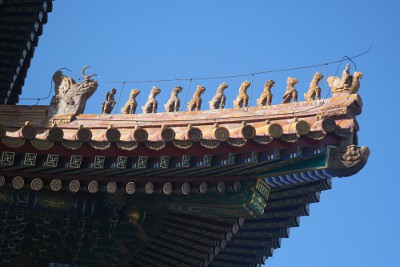Decorative Designs in Chinese Art 中国文物的纹饰
Porcelain 瓷器 Roofs
Click on any word to see more details.
Roofs
Yellow porcelain roof tiles were used to cover structures associated with the emperor. Palace roofs use special glazed roof tiles called liuli way 琉璃瓦 that were for the exclusive use of the emperor. They took 180 days to make with a special purification process and two firings. The tile ends in the Forbidden City feature stamps with a dragon design. Over a hundred million tiles were used in building the Forbidden City in Beijing. The picture below shows a few of them.

The Taihe Hall is the largest hall in the Forbidden City. The ridge end ornaments on the roof are 4.3 tonnes each. One of them is shown in the photo below.
Celestial beings and roof beasts are used to decorate roofs in palaces and temples. The use of nine of these in a row is reserved for the emperor. However, the Taihe Hall is unique in having 10 animals, making a total of 13 with the immortal gardian at the end. The celestial beings and roof beasts on the Taihe Hall are shown below.
Chinese
Pinyin English

